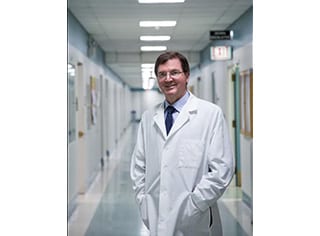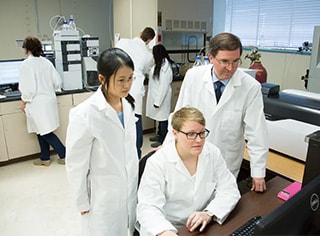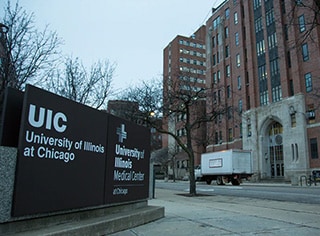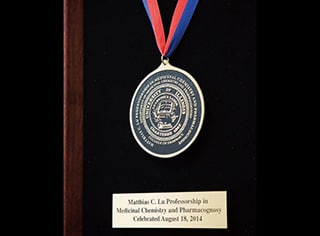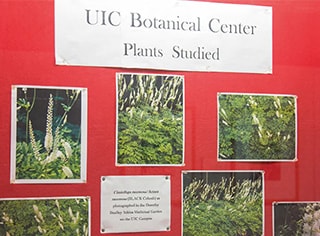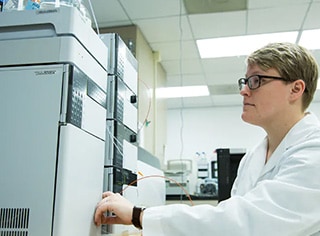Inspiration from natural sources
Spotlight on the work of Richard van Breemen

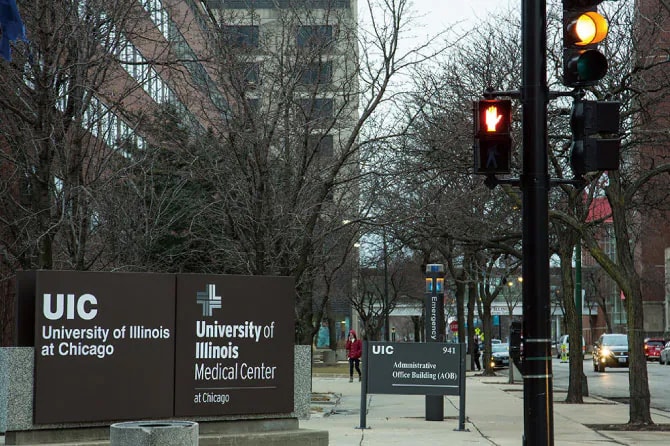
Series: MOMENTUM
A remarkably diverse and productive set of applications for the Shimadzu Corporation’s mass spectrometry equipment have been pioneered by eminent researcher Richard van Breemen

Collaborations between the Shimadzu Corporation and renowned researchers across the globe have rarely been more productive than in recent years. Since the company was founded, Shimadzu’s highly specialized equipment has enabled scientists to make breakthroughs in many different disciplines, from chemistry to medical science. The relationships between Shimadzu and their collaborative partners in research laboratories and academic institutions all over the world work both ways – researchers trained to use Shimadzu’s instrumentation then find new and innovative ways of utilizing it, thus inspiring Shimadzu’s engineers to build the next-generation of equipment.
The eminent researcher Richard van Breemen of the University of Illinois, Chicago(*), has had a long-standing and mutually beneficial relationship with the Shimadzu Corporation for the past 35 years. His connections with the company began during his degree at the Johns Hopkins University in Baltimore, where he was trained to use mass spectrometry (MS) equipment made by Kratos (which later become part of Shimadzu). In the first half of the 1980s, during his early career as a researcher in analytical chemistry for medical science, van Breemen was lucky enough to be taken under the wing of Robert Cotter, the American chemist whose research led to considerable advances in time-of-flight mass spectrometry and contributed to the development of ‘matrix-assisted laser desorption ionization’ (MALDI). Subsequent breakthroughs involving MALDI led to Shimadzu’s Koichi Tanaka receiving the Nobel Prize for Chemistry in 2002.
* At the time of this profile, van Breemen was with the University of Illinois, Chicago. He is now Director of the Linus Pauling Institute at Oregon State University.
“Cotter had a mantra that I’ve subscribed to ever since,” recalls van Breemen. “He would say ‘Never conclude that something can’t be done!’ To my mind, this sums up the attitude of all the scientists and technicians working on early versions of mass spectrometers in the 1980s. Their efforts to make technology such as liquid chromatography mass spectrometers (LCMS) actually work were truly heroic. Without companies like Shimadzu who were willing to push the boat out and work endlessly to develop the technology and make it more and more reliable, little of the work in analytical chemistry conducted in the last 30 years would have been possible.”
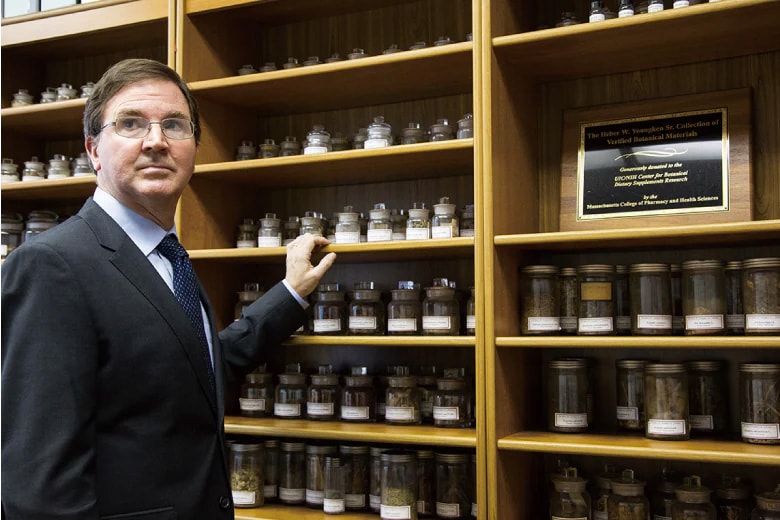
What is mass spectrometry?
Mass spectrometry is a technique used by analytical chemists to determine the ‘signature’ of substance – in other words, its exact chemical make-up including details of the mass and elemental composition. It works by ionizing the substance, creating gas-phase charged molecules from which the mass-to-charge ratio of each can be determined. MS techniques can be used to disentangle the complexities of a substance, be it a naturally-sourced compound from a plant or a prescription drug made in a laboratory. By allowing scientists to ascertain the exact amounts of each constituent molecule that are found in a substance, MS can give great insights into how a particular compound functions and behaves.
There are many different types of MS, and Shimadzu has been a leading light in terms of developing and fabricating equipment to make MS work reliably and effectively in recent decades. van Breemen and his team work regularly, although not exclusively, with several types of MS including time-of-flight (or TOF-MS) mentioned above, as well as ion trap and triple quadrupole MS. Different information about molecules can be uncovered using different MS techniques. The complexity of the natural product mixtures being studied means that these MS-techniques are usually coupled in tandem with liquid chromatography (LCMS).
The concept of liquid chromatography has been around for many decades. This technique is based on the fact that a mixture of compounds will split into its component parts when dissolved in a liquid and passed through stationary phase. The classic illustration of this is to imagine a piece of paper with ink on it – when the paper is dipped into water, the ink will run. If you examine it carefully, you will see the ink has split into different pigments on the paper. This splitting is due to different constituents of the ink moving at different speeds through the stationary phase (the paper). A chromatographic separation allows scientists to simplify a chemical mixture which can then be measured for more detailed molecular information in a mass spectrometer.
The basic premise of MS is that charged molecules or ions can be separated from each other in the gas-phase based on their mass-to-charge ratio. For example, TOF-MS measures the time taken for each ion to travel a set distance to a detector inside the machine. Light ions travel faster, heavier ones take longer. Molecular ions (charged intact molecules) can fragment inside the mass spectrometer, and the various product ions can be recorded in a mass spectrum. Such tandem mass spectra provide structural information about the chemical makeup of each molecular ion. This gives more a more detailed description of the individual components which can be separated out using LCMS.
“We often use ion-trap TOF-MS, or IT-TOF, which can help us to figure out which components bind to a particular enzyme or receptor by measuring their relative masses,” says van Breemen. “In this technique, combined electric fields are used to trap the charged particles so we can then detect, measure and identify individual components, as well as analyze their behavior and interactions with other molecules.”
Richard van Breemen:
A career built on MS
Throughout his early career, after graduating from Johns Hopkins School of Medicine in 1985, van Breemen trained in the use of MS, LCMS and their applications in medicine. He began by investigating the characteristics of natural products such as chlorophylls and carotenoids from plants. He is now considered to be a world-expert in MS techniques applied to natural products, and has pioneered a number of methodologies in the field.
“Everything I do uses MS,” he says. “I investigate drug metabolism and toxicology for existing medications and botanical supplements, alongside focusing on drug discovery from natural sources. I devote a considerable amount of time to the search for new anti-cancer drugs based on natural products from plants. In essence, I study mechanisms of action; investigating interactions between natural products and receptors and enzymes, working out what these compounds do and how they do it. Utilizing MS-based screening is the best way to do this.”
His initial mass spectrometry work on plant compounds led to him being asked to join the Department of Medicinal Chemistry and Pharmacognosy at the University of Illinois at Chicago in the early 1990s, where he still works to this day. At that time, the natural products research team in Chicago was already actively searching for new cancer chemoprevention agents in nature, and would soon embark on the study of the safety and efficacy of botanical dietary supplements, as van Breemen explains:
“Our efforts were, and indeed still are, focused on examining in detail the compounds and molecules found in natural sources, in the hope of finding products that could be used in new medicines. We were also acutely aware of the rise in the use of dietary supplements – non-prescription, botanically-based products that claimed to relieve symptoms of many illnesses and conditions – and our unique chance to study these in more depth.”
These dietary supplements are marketed and regulated in different ways across the world, and every country has a different set of regulations to control them. The aim of the UIC Botanical Center, which is directed by van Breemen, is to provide overarching, detailed research into how these botanical supplements work and interact with the body, and indeed with prescription medications.
“Botanical supplements are often based on extracts from plants that were used in ancient cultures,” explains van Breemen. “By utilising the latest technologies and novel methods of determining the constituent parts of these supplements, we hope to reveal many new aspects of the products available on the market – investigating an old field with new twists.”
Botanical supplements case study:
The menopause
One of the van Breemen group’s key areas of research is to examine the effects of using botanical dietary supplements to treat the symptoms of the menopause in women. Given the negative press surrounding the use of hormone replacement therapies, more women have been turning to alternative medicines such as licorice and black cohosh to relieve symptoms of cramps and hot flushes, for example.
“Although these supplements have been around for ages, there is a lot we still don’t know about them,” explains van Breemen. “We were intrigued to find out how botanical supplements actually work once inside the body, and current technology is finally allowing us to understand how they work – or indeed, if they work.”
In 2011, van Breemen led an investigation into the plant black cohosh, the roots of which have been used in traditional Native American medicines for centuries. His team were keen to add to understanding of the pharmacological profile of the plant, with a particular focus on the nitrogen-containing compounds, which had never been studied before.
They used a Shimadzu IT-TOF-MS to examine plant extracts, allowing them to determine exactly how many atoms of each element there were in the samples. They revealed a diverse set of 73 nitrogen-based metabolites (small molecules created as a direct result of metabolic processes) previously unknown to exist in black cohosh. Indeed, some of the molecules were completely new to science. Their findings may be significant in understanding the biology of the plant, its bioactivity and its efficacy as a dietary supplement.
Metabolites are of particular interest to scientists studying drug mechanisms of action, because many of these small molecules created during metabolism in the body become reactive – they trigger reactions which can prove significant in terms of a drug’s or supplement’s efficacy, or indeed can interfere with other drugs present in the body. Drug-botanical interactions are a serious consideration for researchers involved in drug discovery, as two or more substances taken together can negate each other, or in worst-case scenarios actually prove toxic.
Earlier this year, in March 2015, van Breemen published a paper describing a new methodology for detecting such reactive metabolites in dietary supplements using ultra-high-pressure LCMS (UHPLC).
He became aware that existing technologies, which trapped reactive metabolites using glutathione (or GSH) and then scanned them using high-pressure LCMS, actually missed out some of the GSH conjugates in the final read-out.
To ensure all reactive metabolites could be identified in a single analysis, van Breemen and his team developed a new technique using UHPLC instead, and tested it on a licorice-based supplement called Glycyrrhiza glabra. Their screening test simultaneously measures both positive and negative ions in a single assay, allowing more of the metabolites to be identified than in previous tests. Their results indicated for the first time that licorice forms metabolites which are capable of reacting with biological nucleophiles when consumed as a supplement. Their UHPLC technique has the potential to transform this particular field of study, as van Breemen explains:
“UHPLC separations are fast and Shimadzu’s triple quadrupole mass spectrometers are the fastest on the market today. The name UHPLC, as it might suggest, refers to the pressure used to pump solvent through the chromatographic column – it literally pushes the machine as hard as it can go! From this we gain fantastic productivity; in the search for reactive metabolites using UHPLC with fast scanning triple quadrupole mass spectrometry we were able to speed up the process ten-fold. The technology can also provide crucial support for clinical trials requiring rapid, accurate results.”
Enhancing clinical medicine:
A clear future for rapid analysis
This ability to generate results in minutes from mass spectrometry could prove vital for medical diagnoses, and van Breemen’s group have recently been involved in a number of clinical-based support projects using Shimadzu’s equipment. It is in this field that the brilliance of Shimadzu’s partnerships with researchers comes to fruition. To give an example, van Breemen was asked by a pathologist at a local hospital if it were possible to predict how long an infected liver might function before it fails, purely by examining the constituent parts of a tiny piece of liver taken during a biopsy.
“If Shimadzu had not just released their latest mass spectrometer, the LCMS-8050, this particular project simply couldn’t have been possible,” describes van Breemen. “The biopsy samples were so small that no previous machine could have analyzed them accurately. I have no doubt that these are the kind of challenges Shimadzu’s engineers will continue to rise to in coming decades. I look forward to seeing what they will come up with next!”
As mentioned, the relationship works both ways, and van Breemen is an expert at fine-tuning methods used with Shimadzu’s equipment. In a paper published in November 2015, van Breemen describes a new assay capable of assessing drug-drug and drug-botanical interactions, which could have immense value for both clinical medicine and new drug development. Again using fast UHPLC equipment with a triple quadrupole mass spectrometer, the new assay measures ten different drugs at once in a cocktail, rather than individual species one at a time. The technique examines how each drug is transformed by liver enzymes in vitro, simultaneously measuring the resulting products and the rate at which the enzymes metabolize each drug.
“The second step once we have this information is to see what happens to the individual drugs’ ‘mechanisms of action’ once we add a botanical supplement into the mix,” explains van Breemen. “If there is an interaction between the supplement and a particular drug, or drugs, in the lab test, then it is highly likely there would be implications for that combination inside the body as well.”
Trials of the new technique proved highly successful, with promising results in test runs using drugs with known liver enzyme inhibition activity. The team also conducted tests using the licorice-based Glycyrrhiza glabra, showing that their method was capable of illustrating the effect of a supplement on prescription drugs.
Cancer prevention case study:
The search for promising targets and therapies
van Breemen and his colleagues are heavily involved in conducting analyses in the search for cancer prevention targets and therapies. They research potential proteins inside the body that could provide targets for anti-cancer drugs, as well as investigating products from natural sources that could provide the basis for developing such drugs in future. This versatility stems in part from the team’s expertise in MS techniques, which can be used for both sides of the investigative process. In 2012, for example, van Breemen was involved in the development of a new method of screening for agents that could modify a human protein called Keap1. This protein is heavily involved in regulating antioxidant responses in the body, an important process that protects cells against carcinogens. This means Keap1 could prove to be a viable target for cancer prevention therapies.
A previous trial by the same team using MALDI-TOF MS provided some detail on potential agents for Keap1 modification, but van Breemen was not satisfied that all the interactions were detected using this method. He developed a second, more sensitive assay based on a simpler, one-step LC-MS/MS process. The assay proved to be 20 times more sensitive than the MALDI-based analysis, and was able to identify new potential chemoprevention agents that interacted with Keap1.
For a number of years, a molecule called lycopene found in tomatoes and other red fruit and vegetables has been under investigation as a possible drug candidate for cancer prevention therapy. Lycopene is known to be very safe for human consumption, and exhibits anti-inflammatory, anti-oxidant and anti-cancer properties. It is not yet clear whether the molecule is potent enough in its natural state to actively prevent cancer, however.
The study of lycopene is one of van Breemen’s current projects, in which he is focusing on its potential as a therapy for prostate cancer. The slow growth of prostate cancer over years lends itself to intervention via cancer prevention therapy. To determine the potential of lycopene as a prevention tool, van Breemen and his colleagues must first unravel the mechanisms which occur inside the body when lycopene is consumed.
A significant step forward is described in van Breemen’s 2013 paper in Cancer Prevention Research, wherein his team successfully identified how lycopene affects specific individual protein expression in human prostate cells in culture. Using HPLC-MS/MS equipment, they found that proteins linked with anti-cancer / anti-oxidant responses were upregulated following lycopene treatment. More specifically, proteins associated with apoptosis (programmed cell death) were upregulated, and they found increased levels of a class of protective enzymes which may help prevent cancer initiation. They also observed an anti-inflammatory effect in the prostate cells. Proteins involved in protecting cancer cell growth and cancer-inducing pathways were downregulated.
Crucially, finding these multiple protective effects on multiple molecular pathways would not have been possible without Shimadzu’s latest HPLC-tandem mass spectrometry technology. Repeating these results in vivo (inside the body) has yet to be achieved, but van Breemen remains positive about the power of natural products to treat, and potentially prevent, cancer.
“More than half the drugs in use today stem from natural sources,” he says. “Two thirds of cancer prevention drugs on the market are also from natural sources – there have to be more potential drugs out there that we haven’t found yet. I’m determined to continue searching for compounds that could help us in the fight against all forms of cancer in future.”
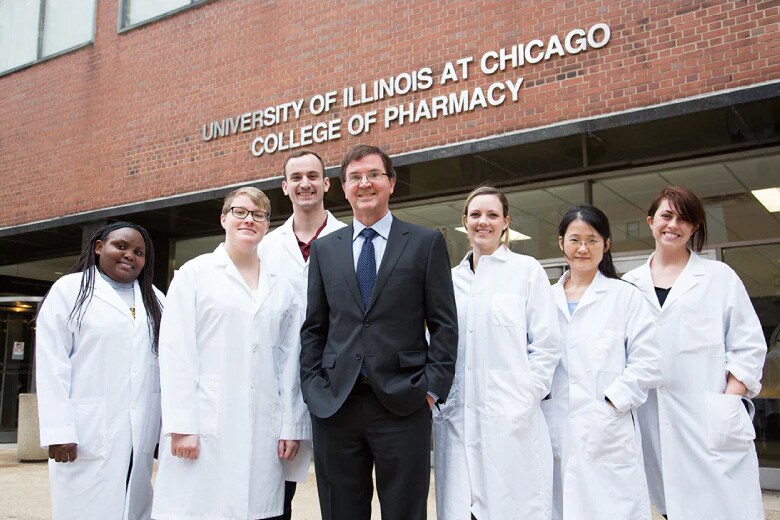
Shimadzu and van Breemen:
A productive future
Given the scope for potential new discoveries that Shimadzu’s equipment provides, it is vital that the corporation continues to work with experts in MS, such as Richard van Breemen, long into the future. Collaborations such as this yield significant and far-reaching results, aiding Shimadzu in its aim to contribute to society through the application of science and technology.
The Center for Botanical Dietary Supplements Research at the University of Illinois has recently been awarded funding for a further five years, and van Breemen is convinced that Shimadzu’s wide variety of LCMS and IT-TOF equipment will continue to help them achieve the Center’s goals.
“Our efficiency, accuracy and productivity are ultimately tied to the equipment we use,” says van Breemen. “Shimadzu’s unending support and their willingness to persevere in building high-performance MS instrumentation enables us to conduct accurate, relevant and unique scientific analyses of compounds which would otherwise remain a mystery. New drugs and anti-cancer therapies are out there, it is simply a case of finding them using the technology available to us.”
* Affiliates and titles of the persons mentioned in this article reflect their status at the time of the interview.
References
Li, G., Huang, K., Nikolic, D., & van Breemen, R.B. High-throughput cytochrome P450 cocktail inhibition assay for assessing drug-drug and
drug-botanical interactions. Drug Metabolism and Disposition 43 (2015)
Huang, K., Huang, L., & van Breemen, R.B. Detection of reactive metabolites using isotope-labeled glutathione trapping and simultaneous neutral loss and precursor ion scanning with ultra-high-pressure liquid chromatography triple quadruple mass spectrometry.
Analytical Chemistry 87 (2015)
Qiu, X., Yuan, Y., Vaishnav, A. et al. Effects of lycopene on protein expression in human primary prostatic epithelial cells.
Cancer Prevention Research Published online March 12, 2013
Sporn, M.B. & Liby, K.T. Is lycopene an effective agent for preventing prostate cancer?
Cancer Prevention Research Published online March 12, 2013
Hu, C., Nikolic, D., Eggler, A.L., Mesecar, A.D., & van Breemen, R.B. Screening for natural chemoprevention agents that modify human Keap1.
Analytical Biochemistry 421 (2012)
Nikolic, D., Godecke, T., Chen, S-N., White, J., Lankin, D.C., Pauli, G.F., & van Breemen, R.B.
Mass spectrometric dereplication of nitrogen-containing constituents of black cohosh (Cimicifuga racemosa L.). Fitoterapia 83 (2012)
 Copied
Copied


